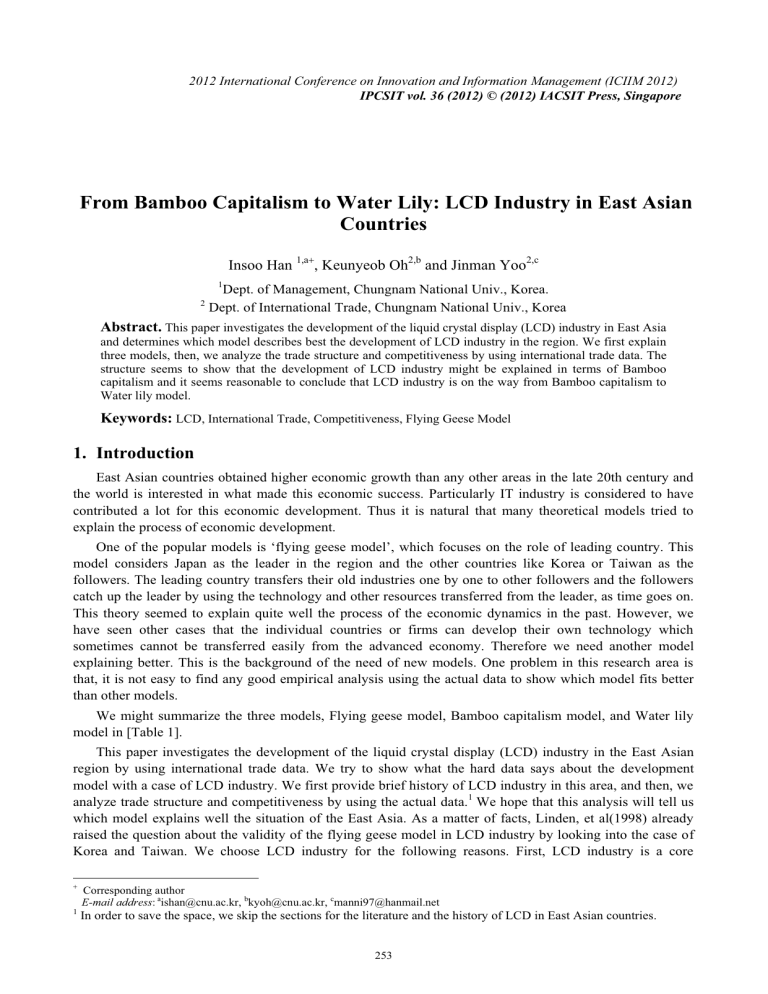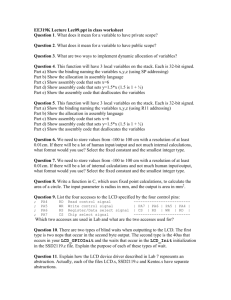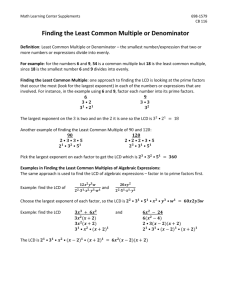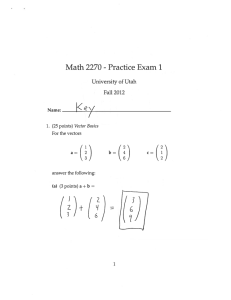From Bamboo Capitalism to Water Lily: LCD Industry in East... Countries Insoo Han

2012 International Conference on Innovation and Information Management (ICIIM 2012)
IPCSIT vol. 36 (2012) © (2012) IACSIT Press, Singapore
From Bamboo Capitalism to Water Lily: LCD Industry in East Asian
Countries
Insoo Han
1,a
, Keunyeob Oh
2,b
and Jinman Yoo
2,c
1
Dept. of Management, Chungnam National Univ., Korea.
2
Dept. of International Trade, Chungnam National Univ., Korea
Abstract.
This paper investigates the development of the liquid crystal display (LCD) industry in East Asia and determines which model describes best the development of LCD industry in the region. We first explain three models, then, we analyze the trade structure and competitiveness by using international trade data. The structure seems to show that the development of LCD industry might be explained in terms of Bamboo capitalism and it seems reasonable to conclude that LCD industry is on the way from Bamboo capitalism to
Water lily model.
Keywords:
LCD, International Trade, Competitiveness, Flying Geese Model
1.
Introduction
East Asian countries obtained higher economic growth than any other areas in the late 20th century and the world is interested in what made this economic success. Particularly IT industry is considered to have contributed a lot for this economic development. Thus it is natural that many theoretical models tried to explain the process of economic development.
One of the popular models is ‘flying geese model’, which focuses on the role of leading country. This model considers Japan as the leader in the region and the other countries like Korea or Taiwan as the followers. The leading country transfers their old industries one by one to other followers and the followers catch up the leader by using the technology and other resources transferred from the leader, as time goes on.
This theory seemed to explain quite well the process of the economic dynamics in the past. However, we have seen other cases that the individual countries or firms can develop their own technology which sometimes cannot be transferred easily from the advanced economy. Therefore we need another model explaining better. This is the background of the need of new models. One problem in this research area is that, it is not easy to find any good empirical analysis using the actual data to show which model fits better than other models.
We might summarize the three models, Flying geese model, Bamboo capitalism model, and Water lily model in [Table 1].
This paper investigates the development of the liquid crystal display (LCD) industry in the East Asian region by using international trade data. We try to show what the hard data says about the development model with a case of LCD industry. We first provide brief history of LCD industry in this area, and then, we analyze trade structure and competitiveness by using the actual data.
1
We hope that this analysis will tell us which model explains well the situation of the East Asia. As a matter of facts, Linden, et al(1998) already raised the question about the validity of the flying geese model in LCD industry by looking into the case of
Korea and Taiwan. We choose LCD industry for the following reasons. First, LCD industry is a core
Corresponding author
E-mail address : a ishan@cnu.ac.kr, b kyoh@cnu.ac.kr, c manni97@hanmail.net
1
In order to save the space, we skip the sections for the literature and the history of LCD in East Asian countries.
253
industry in IT manufacturing. Second, the industry is developed in all of the East Asian countries and this region has almost 100% market share of the world. Third, LCD industry started in Japan first and moved to
Korea, Taiwan and China in order. Last, there are very active international trade and investment among these countries in the industry.
[Table 1] Models for the development in East Asia
Source: B.S. Park(2005)
The East Asian countries, China, Japan, Korea, and Taiwan, have the major market share of the flat panel display (FPD) industry. In particular, these four countries have more than 90% of the thin-film transistor (TFT-LCD; hereafter, LCD) market, the most important segment of the FPD industry. Considering that the LCD industry is expected to grow further, as new IT products with LCDs are being developed, the market power of these countries would seem set to be strong in the future.
In the context of such strong competition, these four countries have specialized, according to their own comparative advantages and, thus, an international division of labor has occurred. Japan supplies manufacturing equipment and materials, Korea and Taiwan have specialized in intermediary goods, like display panels, and China has focused on producing final goods by putting together other parts, components, and materials with cheaper labor.
2.
Trade Structure of the LCDIndustry
2.1.
Concepts and classification of LCD industry
LCD displays use two sheets of polarizing material with a liquid crystal solution between them. An electric current passed through the liquid causes the crystals to align so that light cannot pass through them.
Each crystal, therefore, is like a shutter, either allowing light to pass or blocking the light. The LCD industry consists essentially of three main parts: the LCD panels, materials and components, and LCD manufacturing equipment. Although it is not easy to decide which items of industry classification should be included, we used a harmonized system (HS) classification of the industry. Details of the industry are from the National IT
Industry Promotion Agency of Korea (http://www.nipa.kr). The classification for LCD equipment is from www.kita.net.
254
3.
Trade Structure in the Data
As for Korea, panel industry is the main exporting industry, of which main partner is China, while
Korean exports in MC(materials and components) and ME(manufacturing equipment) are not so much. In particular, Korea shows trade deficit in ME. Japan is not large country in panel while it is clear that Japan has a trade surplus with all the other countries in ME. For Taiwan, panel and MC is its main exporting industry while ME is not that significant in Taiwan exports. The three countries export materials and components to China.
In contrast to the general idea that China is not competitive in this industry, China exports more panels than Korea and the other East Asian countries. However, China’s imports are almost double of its exp orts and China has the biggest trade deficit in the panel industry in East Asia. Further, most of China’s exports are not to the East Asian countries, but to other areas of the world.
From the summary of numbers above, we show the division of labor in [Figure 1]. This is a modification of Shitaku, J. (2008) with more elaboration and is supported by data. PCTAS data from UNCTAD were used in terms of the HS six digits. The directions of the arrows indicate the trade surplus and the thickness shows the size of the surplus. This figure shows the structure of the international trade and the division of labor.
Korea exports panels to Japan, China, and Taiwan, while Korea imports materials and components, and manufacturing equipment from Japan. China is the big importer of LCDs in the region. We suggest other figures in the appendix in order to focus on the exports part in detail. Those figures show exports to rest of the world, too.
Fig.1. International division of labor in the LCD industry
4.
International Competitiveness in LCD Industry
division of labor in the LCD industry of East Asian countries. Trade specification index ( ). The
TSI of each country are shown in [Figure 2]. Japan has very strong comparative advantage in ME and China has no advantage in any industries.
In panel industry (PA), Korea and Taiwan have large scores of TSI, indicating that these two countries are strongly competitive in display panels. Japan has a positive number too. China has negative numbers, although China’s exports are very large. In particular, Taiwan’s TSI is the largest, showing the strong competitiveness of Taiwanese LCD firms. When looking at the details, all three countries have trade surpluses with China in the panel industry. Note that Korea, while it is known to be a strong player in the panel industry, has a negative number in trading with Taiwan. In the industry of LCD materials and components (MC), the results were similar. Three countries other than China have positive and large TSI numbers. Interestingly, Japan’s TSI is large but stable, between 0.6 and 0.7, while those of Korea and
Taiwan have increased sharply. This may suggest that the technology level in these two countries is increasing and that the gap between them and Japan is narrowing. In LCD manufacturing equipment (ME),
255
Japan has the strongest position and other three countries still seem to be far from a competitive position even though Korea is a little higher than the other two.
Fig. 2. TSI’s in all LCD industries countries. First, we use export similarity index (
) which shows the degree of similarity of the exports items between two countries. If this number is big, that means two countries are exporting similar items to other countries.
We are going to use another index for showing export concentration: Herfindahl-Hirshman(H-H) Index.
How a countries export is concentrated on a specific item? [Figure 3] shows that Korea and Taiwan export very similar items recently.
Generally speaking, it is desirable to have lower level of this index. We might see the concentration is very in China while Japan does not depend its export on a single sub industry.
Fig. 3. Exports similarity and export concentration
5.
Summary
We find that Japan has a comparative advantage in the manufacturing equipment and materials and components while Korea and Taiwan has a comparative advantage in LCD panels and China has LCD modules and final product. This result might indicate that Bamboo capitalism model is better than flying geese model in explaining the LCD industry in East Asia. Note, however, that this structure of international division of labor is not the permanent feature. In the future, the increasing role of China in LCD industry and the responses of other countries will determine the shape of international division of labor. At present, China is the big importer and the big exporter of LCD in this region. Although China exports many panels and other products, this study shows that China has a long way to go in the sense that China is importing large panels from Korea, materials and components from Japan, and some components from Taiwan and Japan.
However, it seems that China will become a major player in the future with the support of a huge domestic market and the Chinese government. China is following the track that Korea and Taiwan took in the past.
256
Recently, Chinese government gave allowed two leading Korean companies, Samsung Electronics Co. and LG Display, to build the manufacturing factories in China. Samsung and LG are going to build the state of art technology factories in Suzhou and Guangzhou, respectively. Then, LCD clusters with the firms producing components seem to emerge in these two areas. Therefore, there will be many LCD clusters in addition to the following existing clusters. Now it seems reasonable to conclude that LCD industry in East
Asian area is in between Bamboo capitalism and Water lily model. The industry structure is on the way moving from the one to the other.
6.
References
[1] S-C. Chang: The TFT-LCD Industry in Taiwan: Competitive Advantages and Future Developments. Technology in Society, 27:199-215(2005).
[2] I-S. Han, K.Oh and N. Kim (2011), A Study of Success Factors of Korean LCD industry, Economic Management ,
33(3): 26-36 (in Chinese).
[3] K. Shigehisa, The Flying Geese Paradigm: A Critical Study of Its Application to East Asian Regional
Development, A Paper presented at United Nations Conference on Trade and Development(2004).
[4] G. Linden, J. Hart, A. S.Lenway and T. Muratha, Flying Geese as MovingTargets: Are Korea and Taiwan
Catching Up With Japan in Advanced Displays? Industry and Innovation, 5(1): 11-34(1998).
[5] J. A. Mathews: Strategy and the Crystal Cycle, California Management Review . 47(2): 6-32(2005).
[6] B. S. Park, Rising China and Changes in Model for Regional Development in East Asia., Issue Paper, Samsung
Economic Research Institute.(in Korean) (2005).
[7] J. Shitaku. Manufacturing Technology Strategy in Korean LCD Industry, Akamon Management Review . 7(1): 55-
74 (in Japanese) (2008).
[8] W.
Tri, Dynamic changes in comparative advantage: Japan “flying geese”
model and its implications for China,
Journal of Chinese Economic and Foreign Trade Studies , 1(3):200-213(2008).
257






